Disclosure: Meeple Mountain received a free copy of this product in exchange for an honest, unbiased review. This review is not intended to be an endorsement.
Designer Reiner Knizia has more than 650 games aligned with his BoardGameGeek (BGG) profile. I’m amazed to consider a veteran like Knizia and his bountiful body of work. Knizia has had a hand in getting so many different kinds of games to the table.
His latest game, a co-design with Martino Chiacchiera (the Deckscape series) from HUCH! and R&R Games, is the tile-laying efficiency puzzle game Witchstone. Players take on the roles of witches who have to find the best ways to harness a network of magical energy to move crystals out of their personal cauldrons, build their network across the Witchstone, and acquire scrolls which may grant boosted actions or end-game scoring opportunities.
My favorite Knizia game—and, to be clear, I’m not a Knizia expert, having only played about a half-dozen of his games—is Ra, an auction game now considered one of the best examples of the auction mechanic ever. I also enjoyed The Quest for El Dorado, a light adventure game which I loved mainly for its quick playtime and simplicity.
Once you embrace the theme of Witchstone, the game turns into a tactical puzzle game with a second half that features a few dazzling combos on each player’s turn. That makes Witchstone an appealing, easy-to-teach game that plays in less than 90 minutes.
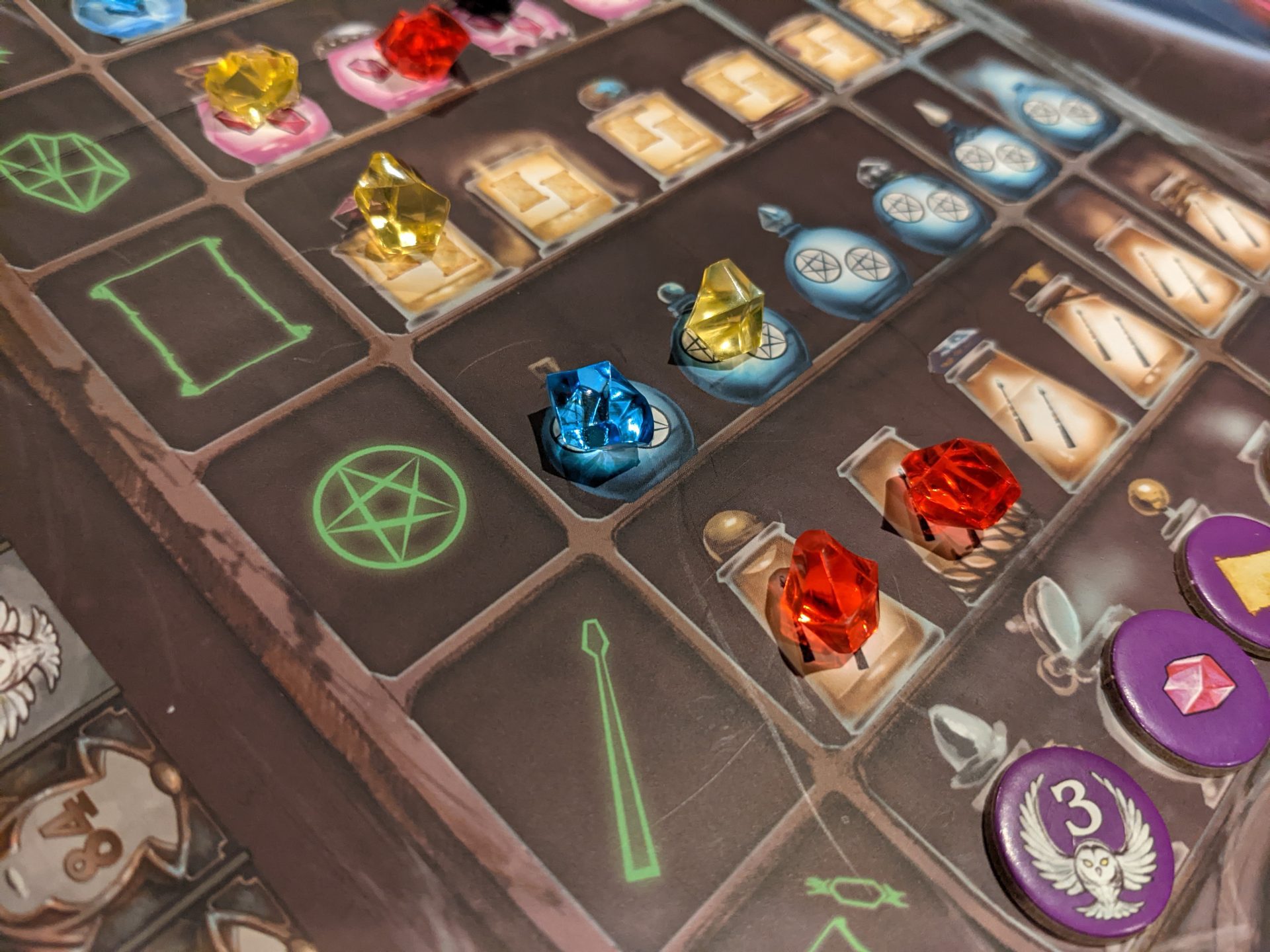
Points? We Got ‘Em
Like other Euro-style efficiency games such as Grand Austria Hotel, Witchstone lays out the rules then gives you a limited number of turns (11!) to make all the magic happen. No matter what you do in Witchstone, you are going to score points almost every turn as long as you maximize your chances at scoring combos later in each game.
That “cauldron” I mentioned above? That’s your player board. It’s got space for dual-action hex tiles, and you have a draw pile of 15 total tiles for the entire game. To start the game, you’ll have 5 of these tiles face-up behind a player screen; on a turn, you must place one of these 5 tiles anywhere you can legally place them on your board.
Each tile has 2 of the 6 total actions available:
- Energy: build a link of energy on paths connected from your starting tower (build a road sounds very un-energy-like, but basically, you’ll be building roads)
- Witch: add a witch from your supply to the board or move a witch to other locations
- Pentagram: move your marker around a track to collect points and single-tile segments which can either be added to your player board or used to take an action twice
- Crystal: move one of the 7 crystals on your player board off an edge, freeing up space for more of your tiles and triggering even more juicy bonuses
- Magic Wand: move up a track to gain bonuses and one-time scoring opportunities (this is also the end-game tiebreaker, which seems to imply this is the most important action in the game; we’ll come back to this)
- Scroll: grab a card; some cards boost future actions while others grant end-game scoring opportunities
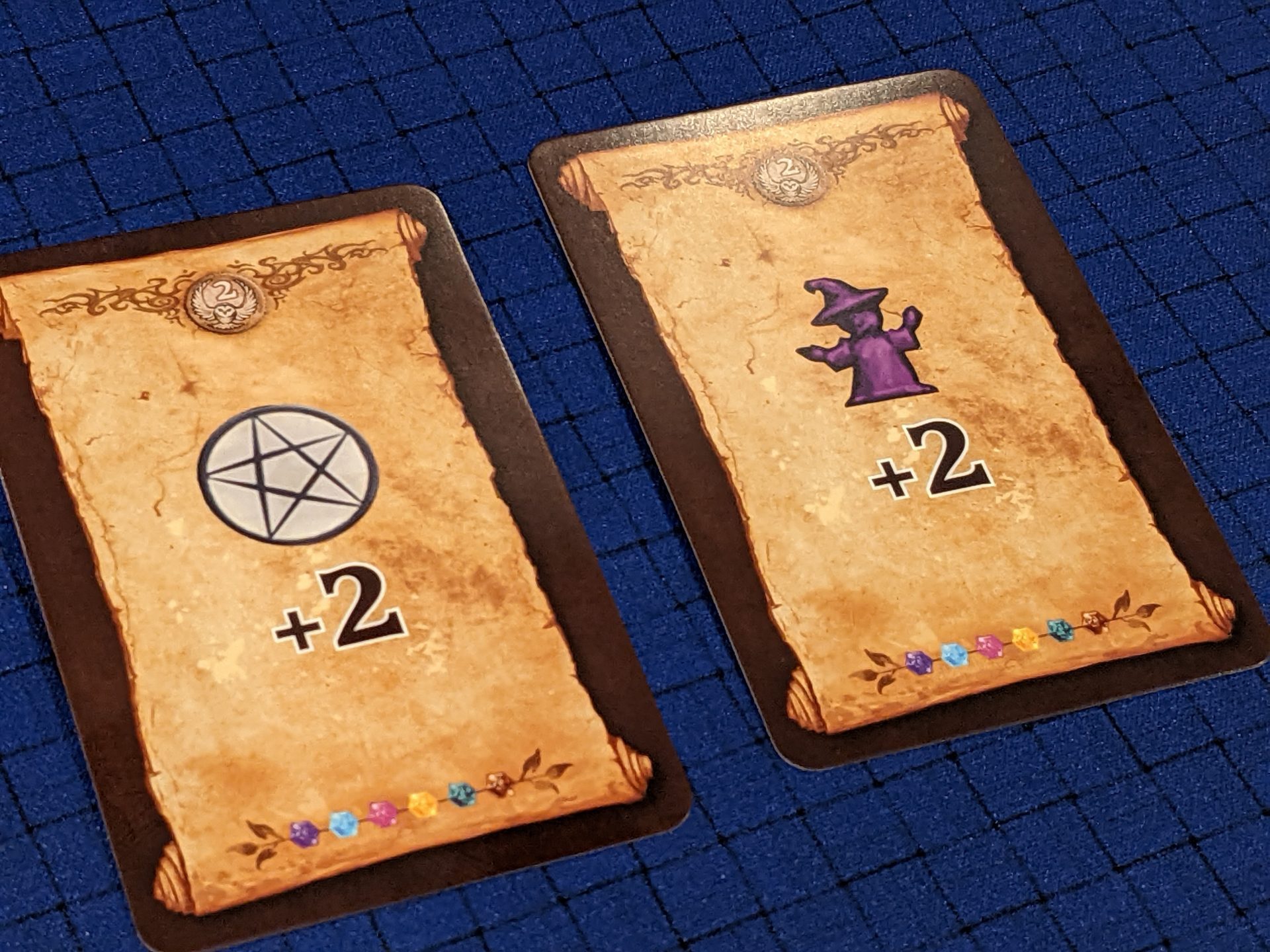
The trick (spell?) in Witchstone is that you get one action for each symbol in the cluster of played tiles, and you must play as many of the number of actions for each side of the played tile as you can. Your player board has each of the 6 actions printed once within the cauldron.
Naturally, then, to start the game, you will play a tile that lets you take one of the 2 tile actions twice. For example, let’s say you have a tile with the Witch action on one end and the Magic Wand action on the other. If you place this tile next to the spot on your board that has a Witch symbol, with the tile side showing the Witch action adjacent to the Witch symbol pre-printed on the board, you get to take the Witch action twice. You can play your 2 tile actions in either order before passing to the next player.
In the first few rounds, it’s hard to chain big combination actions together, so engagement is somewhat muted. You won’t be pumping your fist as you move your token on the magic wand once, and moving a crystal two spaces towards the edge of the player board. You won’t howl at the moon when you get to move three spaces around the Pentagram track, granting you the chance to add a special hex tile to your board for better combinations in future turns.
But you can sense that the setup is coming. And when it arrives, it’s a blast to take some of the later turns.
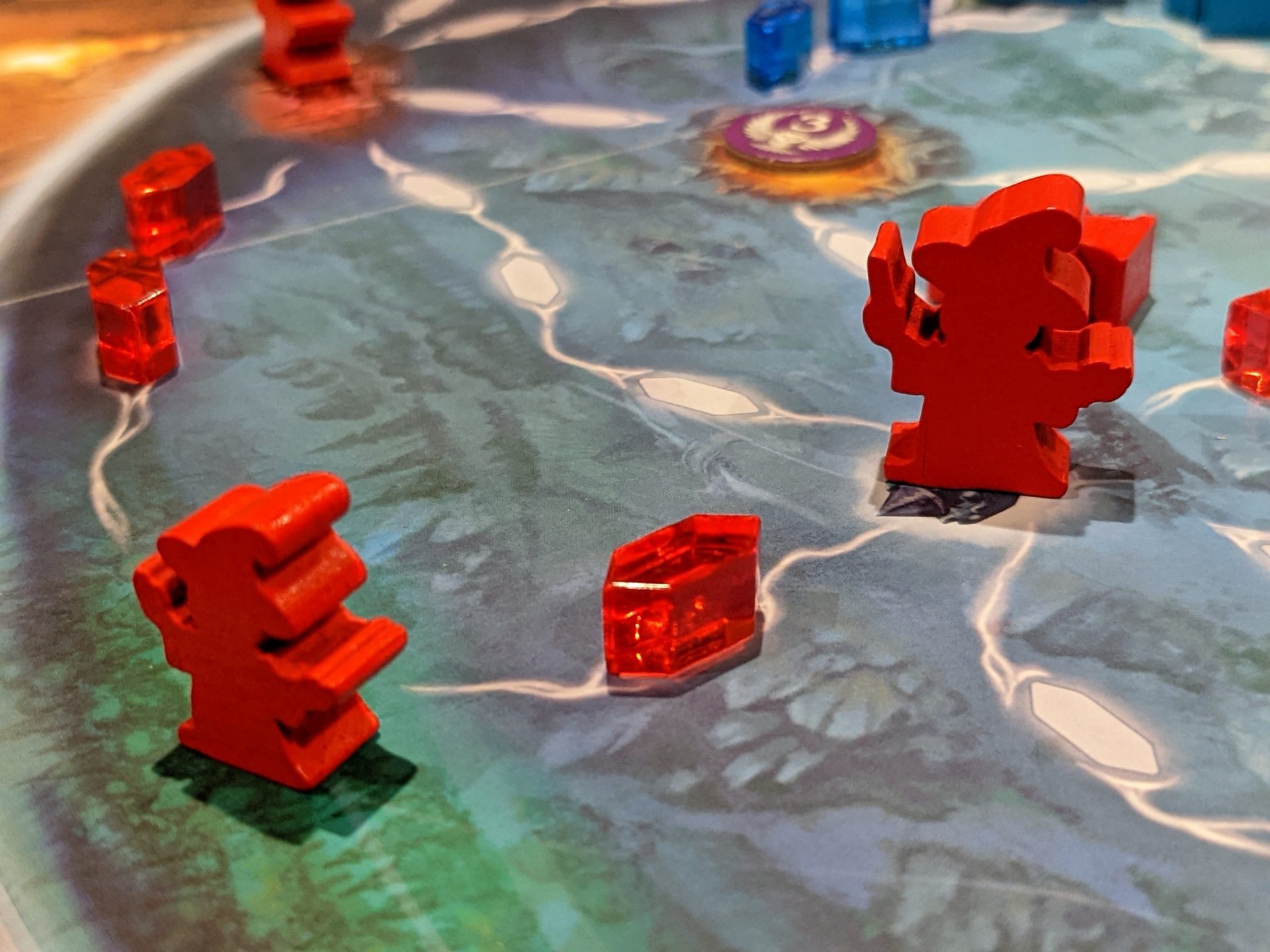
Wait…We Have to Share the Player Aid?
WAIT A SECOND. A shared PLAYER AID?
Let’s talk. The review copy I was given at PAX Unplugged by R&R (I’m told this is the same as the retail release of Witchstone) has a rulebook printed in German, English and French. There are 4 player aids included in the box: 2 in German, one in French, and one in English.
No, I don’t know why there is only one in English, and it’s a shame because the player aid is pretty good. But 3 of our players in my first 4-player game had to pull up the player aid on their phone rather than asking to regularly pass the player aid around the table!
I can forgive this oversight because of those juicy combos.
Turns 6-11 in a typical game of Witchstone are the main reason why it can be fun to play these efficiency games. Pulling off a monster move—heck, even watching an opponent pull off something cool—is a great feeling, especially when your two main actions unlock some of the 4 actions you didn’t include in your tile when placed on the player board. I have had turns where I was able to take 5 of the 6 possible actions through some of the purple “Magic Chips” collected during Witch actions combined with Crystal actions resulting in those crystals being placed in other categories.
These big moments are great. But, is Witchstone as memorable as its moments?
No.
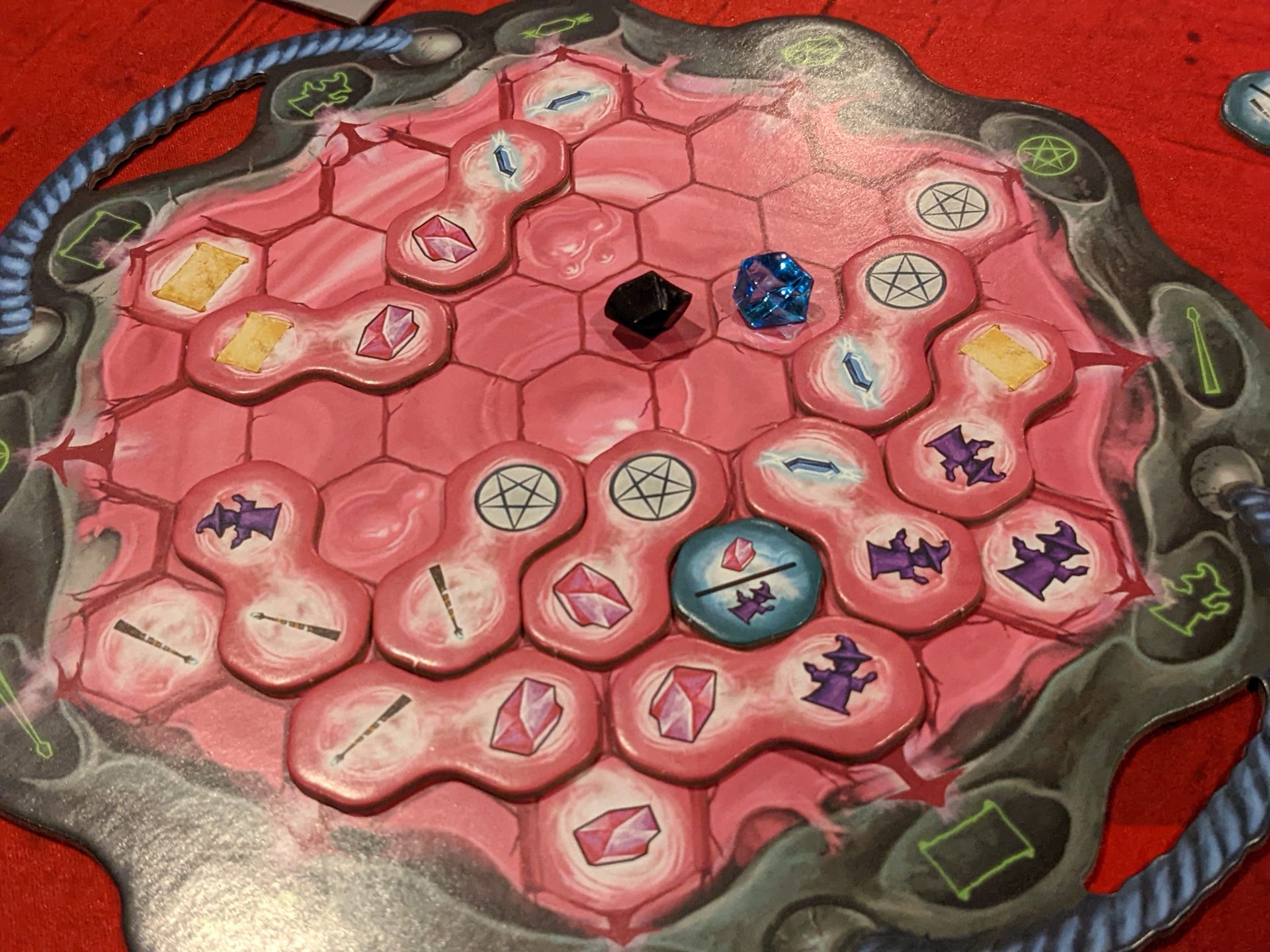
Your Salad, Elevated
Witchstone is fun. It’s a point salad that is a slow starter with big moments down the stretch, featuring very accessible gameplay and solid, if not spectacular, design. In my second play with 3 players, one of my friends talked about Witchstone as a game you could potentially use to introduce newer players to the hobby; it’s a puzzle, sure, but Witchstone is a puzzle that rewards everything a little and the right things a lot.
This will mean that your best Euro-style gamer is likely going to be the winner every time out, even if they have never seen the game before. I am OK with that; games shouldn’t always require 5+ plays to figure out what’s going on, and the experience is snappy and fun. It’s hard to imagine a scenario where you will be telling your friends 2 years from now about that time you pulled off an 8-action Pentagram combo in your first game of Witchstone.
And that’s fine. Witchstone provides a fun experience and a solid production, but it’s not a game that will stand the test of time (the test of time in my collection, that is).


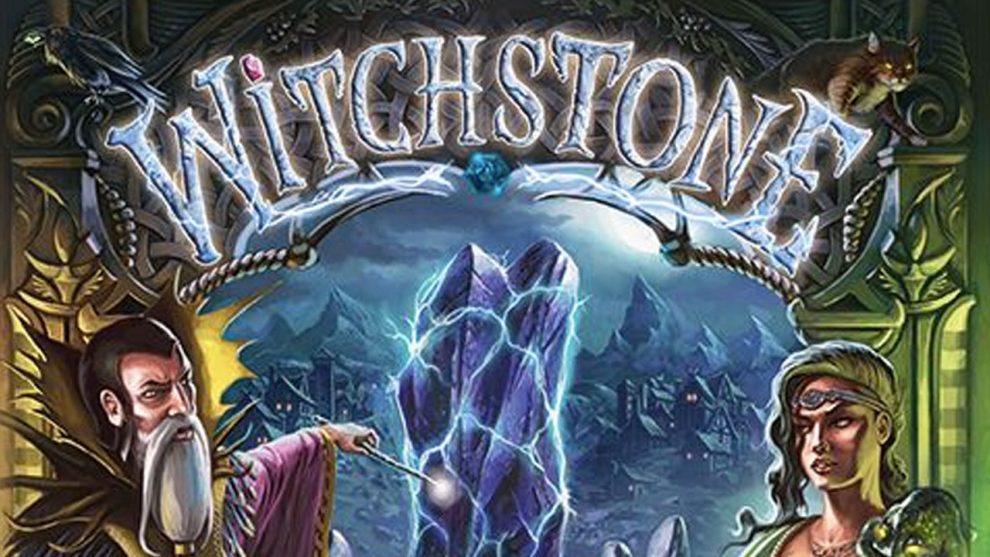




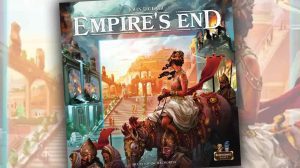




Add Comment